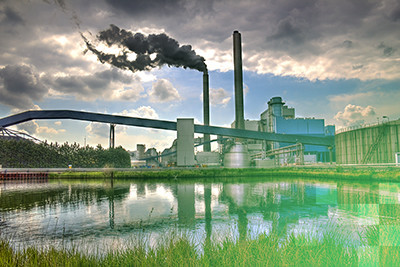
Half Way to the Point of No Return
As world’s “carbon budget” depletes, corporations turn to science in effort to avert environmental calamity
Scientific research has concluded that once average global temperatures rise 2° C above pre-industrial levels (1870 baseline), the adverse impacts of global warming – extreme weather, rising ocean acidity, floods, droughts, and rampant disease – will be irreversible. Based on the current global rate of heat-storing greenhouse gas emissions, the World Resources Institute reports that we could reach that point of no return within the next 28 years.
It’s a dire prediction, backed by massive amounts of data. Even in light of recent revelations that scientists may have manipulated data to meet “politically predetermined” conclusions (National Oceanic and Atmospheric Administration’s 2015 climate change study), one would be hard-pressed to dispute that, as a society, our actions are forcing unnatural changes in the composition of the Earth’s atmosphere. While the Earth can likely survive any damage humans cause, it is the viability of the human race that is in question, according to Katrina Edwards, a geomicrobiologist at the University of Southern California. In a LifeScience.com article, Edwards concluded: “The Earth could care less. We will be recorded as a minor perturbation in the Earth system. The Earth will go on. The question is: Will we?”
Fair Share
With a challenge this big and stakes this high, the responsibility to affect the changes necessary to avoid a human cataclysm must be born by the entire global community. At the same time, as the world’s largest source of emissions, the corporate sector must do its “fair share,” according to Maxfield Weiss, global social and environmental responsibility manager, Hewlett Packard Enterprise. Increasingly, companies like HPE and Walmart are calculating that “fair share” based on methodologies developed by the Science-Based Target Initiative, (SBTi) a joint program of the CDP, UN Global Compact, the World Resources Institute (WRI) and World Wildlife Fund. An emissions reduction target is considered “science-based” if it is in line with the level of decarbonization required to keep global temperature increase below 2°C compared to pre-industrial temperatures, as described in the Assessment Report of the Intergovernmental Panel on Climate Change (IPCC).”
In April, Walmart launched “Project Gigaton,” an initiative to provide its suppliers with an emissions reduction toolkit. This project will support the retail giant’s aim of reducing its absolute Scope 1 and 2 emissions 18 percent by 2025 and eliminating one billion tons (a gigaton) of CO2e, or carbon dioxide equivalent, emissions from upstream and downstream Scope 3 sources by 2030. To put this target into perspective, Euan Murray, chief executive of The Sustainability Consortium, explained that a gigaton of GHG is the equivalent of the annual carbon footprint of the country of Germany.

“It’s hard to conceive of how much that is. While there is no doubt that it is a stretch goal, when we are talking about a company with Walmart’s scale and an extended supply chain that is even bigger, it is definitely achievable,” said Murray. “The most important point is that this is what Walmart’s science-based target says they should be delivering to make good on their commitment to climate science.”
Michael Rohwer, associate director, Information and Communications Technology, BSR, added that while he understands that there is some skepticism about the viability of Walmart’s gigaton target, focusing on the enormity of the goal “misses the point.” Rohwer explained, “What Walmart is doing is exercising leverage in a very public way to give an example for other companies to follow. Walmart is a company that has the ability to influence other influencers. For them to set such a clear target gives a pathway for other companies to begin the process of assessing their supply chain and figuring out how they are going to meet their targets.”
Leading with Science
HPE’s “Living Progress” is another example of a company with strong influence taking a leadership position to address a really difficult challenge, said Rohwer. In May, HPE announced what it claims to be the “the world’s first comprehensive supply chain management program based on climate science.” In addition to previously announced goals for its own operations, including a commitment to reaching 100 percent renewable energy through RE100, a science-based target to reduce operational GHG emissions by 25 percent, and a goal to increase the efficiency of HPE’s product portfolio 30 times by 2025, HPE will now enable 80 percent of its manufacturing suppliers to set science-based emissions reduction targets within their own operations, seeking to avoid 100 million tons of emissions. As part of the goal, HPE has pledged to reduce manufacturing-related GHG emissions on an absolute basis within the supply chain by 15 percent by 2025.
“Our aim is to be a trusted sourcing partner to our customers by manufacturing our goods and services in a way that is more environmentally friendly,” Weiss noted. “So it is important for us to be able to relate to our customers that we are helping to drive this throughout our supply chain.”
According to the CDP report, Harnessing the Power of Purchasing For a Sustainable Future, an organization’s supply chain emissions are, on average, four times greater than emissions from their direct operations. Yet, in 2016, only 22 percent of companies actively engaged with their own suppliers on GHG emissions and climate change strategies.
Leveraging available resources from SBTi as well as BSR and Point380, HPE will provide suppliers with a range of free tools and capability building resources to help them mature along the sustainability pathway. “We are not going to dump a target on the suppliers and say – go get it done,” said Weiss. “What we hope to do is to help advance our suppliers and give them the tools and support to be on a course that most have already stated that they want to be on. Right now, science-based targets are the most aggressive way to set emission-reduction goals, so if suppliers are meeting these requirements, they should be well above the mark in terms of regulatory or other environmental guidelines.”

To further incentivize suppliers, HPE will tie its procurement decisions to suppliers’ social and environmental performance. “It is important that suppliers understand that they will be accountable to these targets,” he said. Suppliers are expected to publish an annual sustainability report and declare their data and progress towards goals through the CDP disclosure system, which is available to investors, customers and the public. “This will put greater scrutiny on the suppliers and the goals they are setting.”
BSR’s Rohwer noted that the HPE program is a great example of using data to help set a standard: “This is part of what the advanced digitization of the supply chain can lead to. In the past, companies could not provide this kind of transparency because there wasn’t the technology available to crunch this much data in such a way that protect key confidential business information and yet is still transparent enough to achieve these sustainability outcomes.”
HPE is positioning its program as an open source tool that other companies in the IT sector can use to ensure that suppliers are accurately measuring and actively working to reduce their carbon footprint. “We know that affecting change in the supply chain is not easy, but it is where a sizable share of our emissions occur,” said Weiss. “We see that many different companies are trying to achieve many different things with many different goals and many different capability-building programs, some of which are as ‘scientific” as sticking a finger in the air and seeing which way the wind blows. So, this is something we can do to help create some sense of standardization for promoting greater sustainability within the supply chain.”
HPE’s goal, according to Weiss, is not to dictate an industry standard, but to start the conversation: “We want to push the envelope so we can get the conversation going. We want this to be driven by experts, to draw on voices in the field, to really think about what the bar for a best in class supply chain GHG program should look like, and to set a standard so we can work collectively to solve this very important issue in a way that will also be business-friendly. That is how we will achieve true success.”